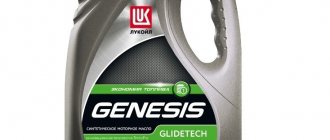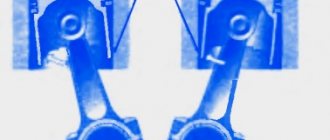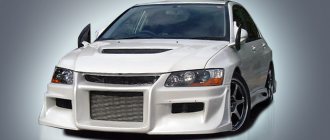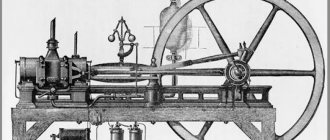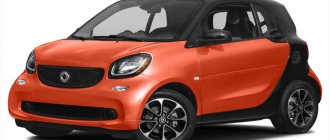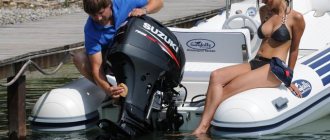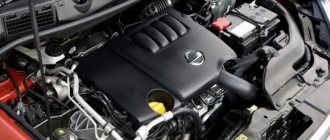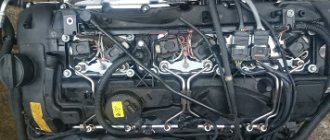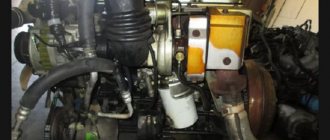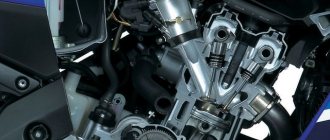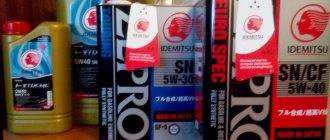Choosing between petrol and diesel
There is a constant debate between car owners about which engine is better - gasoline injection or diesel. So, it’s worth understanding these aspects in more detail, as well as determining which power unit is worthy of more careful attention.
Japanese engines are some of the best in the world.
Before you start considering, it’s worth understanding what the difference is between a gasoline and diesel engine. Of course, the answer immediately suggests itself - in the fuel supply and injection system. By and large, there is no fundamental difference between gasoline and diesel.
It all depends on the intended use. Of course, diesel engines are much more powerful and were originally intended as traction power. But, in the modern world, every car enthusiast chooses what he likes best.
There is an opinion that diesel should consume less fuel, but many Japanese power units have much higher consumption than gasoline engines. Proof of this is the Toyota Land Cruiser Prado.
Let's take a closer look at the difference between a gasoline and diesel engine in terms of design. To do this, you will have to consider the operating principle of both power plants separately.
Engine Manufacturer Nissan
The Nissan company is another large Japanese manufacturer of cars and their components. Just like Toyota, this brand is famous for its high-quality engine assembly. But to achieve high quality when creating internal combustion engines, specialists from the Nissan concern use their little secrets. Namely:
- Installation of steel gears and a chain drive on the gas distribution mechanism (most cars have rubber belts in the timing system, which wear out very quickly. And the belt drive can last up to 200 thousand kilometers);
- Reinforcement of the cylinder block (due to the reinforced frame, the blocks of Nissan cars do not crack during severe overheating. And this saves car enthusiasts not only from high costs, but also from a serious traffic accident);
- Refinement of the fuel system (many Nissan engines can use 76 gasoline as the fuel mixture. Moreover, such low-quality gasoline will not have a detrimental effect on the car’s power unit).
The entire model range of Nissan manufacturers includes about 100 different power units, with in-line and V-shaped designs, 8, 12 and 24 valves, as well as gasoline and diesel power systems. But the most popular engines from the Nissan concern are:
Nissan RB26-DETT
In-line “six”, with a displacement of 2.6 liters, producing up to 280 horsepower. This power unit was developed by the Japanese concern back in 1989, for the sports models Skyline and GT-R.
But the 24-valve design of the gas distribution mechanism made it possible to install a turbocharged compressor on such an engine, due to which the maximum power increased to 330 horses. And this only expanded the scope of the internal combustion engine, including the newer R34 and Stagea 260RS models.
Nissan TDV8
V-shaped “eight”, with a cylinder capacity of 3000 cubic meters, and a power of up to 240 horsepower. Sample for the series of Japanese SUVs Patrol, Pasfinder and Terrano. Due to the timing chain drive, such an engine has a high level of reliability, and the 32-valve gas distribution mechanism provides it with excellent dynamics. The only drawback of such an internal combustion engine is the insufficient amount of free space under the hood.
Of the most problematic Nissan engines, only one power unit can be distinguished: SA-20. It is equipped with a dual-circuit ignition system, which constantly fails.
The principle of operation of a gasoline power plant
In gasoline engines, a mixture of fuel and air is prepared outside the cylinder in the intake manifold. The exception is engines with direct injection. At the end of the compression stroke, the final mixing of gasoline vapor and air occurs. A mixture that spreads evenly throughout the cylinder is called homogeneous.
The compression process leads to heating of the mixture, its temperature reaches 400-500°C, however, the compression ratio in gasoline installations is limited to 9-10 units. This is not enough for the fuel charge to self-ignite, so in such engines the spark plug, the working part of which is located in the cylinder, is the source of ignition.
Detonation processes that occur in gasoline engines when compression increases do not allow the compression ratio to be raised above 11 units. Increasing the octane number of fuel reduces them, but does not allow achieving the performance of diesel units. In addition, the proportional ratio of fuel and air when preparing the working mixture is in a narrow range, which makes it difficult to achieve an ideal result.
Diesel units also belong to internal combustion engines, but the principle of their operation differs from that of a gasoline unit.
Engine 2jz-gte
2jz-GTE Installed in Toyota Supra. Brief performance characteristics: 3.0-liter turbocharged inline-six. Designed for rear wheel drive. Withstands power up to 700 hp. without internal changes. Has great potential.
Along with the 1j2, a second, larger-volume version of the jazet, the 2JZ, was also produced, replacing the previous 7M motor. 2JZ is the same in-line six in a cast iron block, with a volume of 3 liters, which were obtained by increasing the piston stroke, the 2JZ cylinder block is higher than 1JZ, and this is where the main differences between 1JZ and 2JZ end.
Otherwise, the same two-shaft engine, 4 valves per cylinder, with a timing belt, serving about 100 thousand km, intake manifold with adjustable ACIS geometry, since 1997 the engines have been equipped with VVTI, there are no hydraulic compensators, the valves are adjusted with washers, every 100 thousand km
buy 2JZ-GTE engine
The best engines from Japan - tuning project
Operating principle of a diesel power plant
The engine of a diesel power plant operates on a completely different principle. During the compression process, only air is in the cylinder, and the coefficient is about 15-25 units.
Japanese Toyota engine.
Due to this pressure, the temperature inside reaches 700-900°C. Directly before the top dead center of the piston, a portion of diesel fuel is sprayed into the cylinder. Small droplets instantly evaporate and form a fuel-air mixture, which immediately ignites under compression.
Unlike a gasoline engine, the formation of a working charge inside the cylinder in a diesel unit occurs faster; for this reason, the mixture does not have time to become homogeneous throughout the entire volume and is heterogeneous.
Motor v18/v16
B18/B16 Installed, Civic Si. Brief performance characteristics: 1.8- or 1.6-liter four-cylinder in-line naturally aspirated. Designed for front wheel drive. Fast and light inexpensive motor.
The uniqueness of the B-series is that only it managed to combine the truly civilian characteristics of B20B, and the fantastic sports abilities of B16B or B18C. The most amazing thing is that B-series engines can easily “crossbreed” within the line, which gives excellent final results. Many breeders and tuners take advantage of this, creating hybrids that are superior in power to the turbo engines of competitors.
buy a B18 or B16 motor
The best engines from Japan - tuning project
Operation of power plants
The operation of any mechanism has its own characteristic features, especially if we are talking about installations whose operating principles differ from each other. The operation of gasoline and diesel engines has the following features:
Toyota motor.
Diesel power plants are more durable. This is due to the design features of the units. A more powerful cylinder block, a reliable piston group, a reinforced crankshaft and cylinder head, all of this increases the service life of the mechanism. Diesel fuel, having the properties of a lubricant, has a positive effect on the operation process.
During operation, a diesel engine heats up to higher temperatures, therefore, for its normal operation, the cooling system must be more bulky.
For normal operation, a gasoline engine requires finer tuning. The injection, ignition, etc. system must be well adjusted. The motor has a larger number of electrical elements: high-voltage wires, spark plugs, distributors. If one of the mechanisms or parts fails, troubleshooting can take a lot of time.
When determining which engine is better, one cannot ignore the fact that diesel engines tolerate sub-zero temperatures less well. Diesel fuel thickens greatly in cold weather; without special additives, the process begins at −15°C.
To solve this problem, it is necessary to refuel in time with a winter type of fuel, with a lower freezing threshold, otherwise problems will begin with the fuel pump and filter, which are designed to work with a liquid of a certain viscosity.
Gasoline engines are afraid of water. This is due to the fact that over time, microcracks form in the wiring, into which moisture enters. For this reason, it is impossible to create a high-quality spark necessary for engine operation. A diesel unit only needs electricity to start the engine, then it works autonomously.
Motor Honda D16.
Motor 13B-REW
13B-REW Installed in Mazda RX-7. Brief performance characteristics: 1.3-liter biturbo. Designed for rear wheel drive. Rotary piston engine. More than 190 hp are produced from one liter of working volume of this engine.
The twin-turbo version of the 13v, the 13v-rew engine, became known for its high power and low weight.
Two Hitasni NT-12 turbines were installed in series. It is noteworthy that it was the world's first engine in terms of production volume with a sequential twin turbocharging system. The estimated engine power was 280 hp. (206 kW) on a Mazda rx-7. Installed on Mazda rx-7: 1992-1995 (255 hp, 190 kW), 1996-1998 (265 hp, 197 kW), 1999-2002 (280 hp, 206 kW).
buy motor 13B-REW
The best engines from Japan - tuning project
Manufacturers and characteristics of some popular motors
Japanese engines have a wide range of engines that will appeal to any car enthusiast.
Toyota
Toyota Motor Corporation is the largest Japanese and global automaker, one of the largest corporations in the world. Toyota owns manufacturers such as Lexus and Scion, as well as more than 50% of the shares of the manufacturer Daihatsu.
Tuning the 4A “Black Top” engine.
Lexus was created by analogy with Nissan's Infiniti and Honda's Acura, as a premium brand, and Scion as a youth brand. Considering this, it is not surprising that Toyota, Lexus and Scion cars are maximally unified in terms of design, technical components, and sometimes have very minimal differences.
In Russia and the CIS countries, Toyota is traditionally popular, has a reputation as a manufacturer of reliable, durable cars, and some engine brands are considered millionaires.
Toyota engines are a huge line of all kinds of power plants, mostly gasoline.
The most popular, of course, are four-cylinder engines with various markings. Such engines can be either naturally aspirated or turbocharged, compressor, etc. Well-known representatives of in-line fours are: 4A-GE, 3S-GE/GTE, etc. Larger Toyota engines such as in-line 6-cylinder or V6 were also produced and are being produced.
The most famous of them are: 1JZ, 2JZ, 1G and all their types. For larger cars, Toyota engines have a V8 configuration: 1UZ-FE and others. Models with V10 and V12 configurations are quite rare.
Along with Toyota gasoline engines, a range of diesel engines is also produced, mainly consisting of in-line four-cylinder and in-line six.
In addition to traditional power units, Toyota also produces hybrid engines. The most famous car with this installation is the Toyota Prius. The key to a long service life of a Toyota engine is oil; by choosing the right oil, the car enthusiast will significantly extend the life of your power unit.
Engine 1HD FTE.
Let's look at some technical characteristics of popular Toyota engines:
1G
| Name | Characteristics |
| Manufacturer | Shimoyama plant |
| Year of release | 1979-2005 |
| Motor brand | 1G |
| Volume | 2.0 liters (1988 cc) |
| Power | 105-210 hp |
| Compression ratio | 8.8 (1G-EU) 9.2 (1G-GEU/EU) 8.5 (1G-GTEU/GTE) 8 (1G-GZEU/GZE) 9.6 (1G-FE) 10 (1G-FE BEAMS) 9.5 (1G-GE) |
| Torque | 146/4400 (1G-EU) 160/4400 (1G-EU) 160/4400 (1G-EU) 162/4600 (1G-GEU) 172/4000 (1G-GEU) 186/5200 (1G-GEU) 245/ 3200 (1G-GTEU) 280/3800 (1G-GTE) 210/4000 (1G-GZEU) 230/3600 (1G-GZE) 180/4400 (1G-FE) 185/4400 (1G-FE) 200/4400 ( 1G-FE BEAMS) 186/5400 (1G-GE) |
| Cylinder diameter | 75 mm |
| Number of cylinders | 4 |
| Number of valves | 12-16 |
| Fuel consumption | 9.8 liters for every 100 km in mixed mode |
| Engine oil | 0W-30 5W-30 5W-40 10W-30 10W-40 10W-50 15W-50 |
| Resource | 300+ thousand km |
| Applicability | Toyota Crown Toyota Mark 2 Toyota Supra Toyota Altezza/Lexus IS 200 Toyota Chaser Toyota Cresta Toyota Soarer |
3UZ
| Name | Characteristics |
| Manufacturer | Tahara Plant |
| Year of release | 2000-2010 |
| Motor brand | 3UZ FE |
| Volume | 4.3 liters (4292 cm3) |
| Power | 282-304 hp |
| Torque | 417/3500 434/3400 441/3400 |
| Cylinder diameter | 91 mm |
| Number of cylinders | 8 |
| Number of valves | 32 |
| Fuel consumption | 11.4 liters for every 100 km in mixed mode |
| Engine oil | 0W-30 5W-30 5W-40 10W-30 10W-40 |
| Resource | 500+ thousand km |
| Applicability | Lexus GS 430 Lexus LS 430 Lexus SC 430 Toyota Crown Majesta Toyota Soarer |
Nissan
Nissan Motor Company is a large Japanese car manufacturer, covering a significant part of the market in Russia and the CIS countries. In addition to the main brands, this association controls the following brands: AvtoVAZ, Datsun, Dacia, Infiniti and others.
NISSAN JUKE engine.
The total volume of vehicles sold by the alliance is quite large, which allows the association to take a place among the top five global automakers. Some cars of these brands partially overlap with each other and have common platforms, components, assemblies, etc. This is especially true for Infiniti, the company's luxury division created in response to Honda's Acura and Toyota's Lexus.
Let's look at some technical characteristics of popular Nissan engines:
GA16DE
| Name | Characteristic |
| Brand | GA16DE |
| Marking | 1597 cm cube |
| Type | Carburetor/Injector |
| Power | 90-115 hp |
| Fuel | Petrol |
| Valve mechanism | 8-16 valve |
| Number of cylinders | 4 |
| Fuel consumption | 8.0 liters |
| Piston diameter | 76 mm |
| Resource | 250 - 300 thousand km |
SR20DE/DET
| Name | Characteristic |
| Brand | SR20DE/DET |
| Marking | 1998 cm cube |
| Type | Injector |
| Power | 115-280 hp |
| Fuel | Petrol |
| Valve mechanism | 16 valve |
| Number of cylinders | 4 |
| Fuel consumption | 8.7 liters |
| Piston diameter | 86 mm |
| Resource | 400 thousand km |
QG15DE
| Name | Characteristic |
| Brand | QG15DE |
| Marking | 1498 cm cube |
| Type | Injector |
| Power | 90-109 hp |
| Fuel | Petrol |
| Valve mechanism | 16 valve |
| Number of cylinders | 4 |
| Fuel consumption | 6.6 liters |
| Piston diameter | 73.6 mm |
| Resource | 250 thousand km |
Mitsubishi
The extraordinary popularity of components and assemblies produced by Mitsubishi, far beyond the borders of the land of the rising sun, is explained by cooperation with prestigious car manufacturers such as Renaut, Volksvagen, Volvo and other world-famous manufacturers.
Engine 4B12.
The Japanese automobile corporation MMC is an integral part of the Mitsubishi production group, where it occupies one of the leading positions.
Since the company's priority activity is the production of small-sized vehicles, most Mitsubishi engines are represented by compact power plants. Depending on the model, three or four cylinders are located in one line. The most common is a four-cylinder unit configuration.
The most famous representative of this series is the 4G63, additionally equipped with a turbocharging system. It is distinguished by incredible power and extreme propensity for tuning.
Over time, the production of passenger cars is increasingly being replaced by SUVs and crossovers. Increased power is achieved by using the V6 configuration in Mitsubishi engines. In addition to large units with large capacity, power units with a volume of 1.8 liters are produced. The smallest six-cylinder Mitsubishi engines are also known, with a capacity of only 1.6 liters.
In addition to gasoline units, MMC Corporation specialists also manufacture diesel units. They are not very diverse, mostly appearing as in-line four-cylinder engines.
Motor 4G18.
Let's look at some technical characteristics of popular Mitsubishi engines:
4G15
| Name | Characteristics |
| Manufacturer | Mitsubishi Motors Corporation |
| Motor brand | 4G15 |
| Volume | 1.5 liters (1468 cm3) |
| Injection | Carburetor/injector |
| Power | 92-180 hp |
| Cylinder diameter | 75.5 mm |
| Number of cylinders | 4 |
| Number of valves | 12-16 |
| Fuel consumption | 6.4 liters for every 100 km in mixed mode |
| Engine oil | 5W-20 5W-30 10W-40 |
| Resource | 250+ thousand km |
| Applicability | Mitsubishi Colt Mitsubishi Lancer Mitsubishi Dingo Mitsubishi Maven Mitsubishi Mirage BYD F3 Dodge Colt Eagle Summit Hyundai Excel Proton Saga Proton Satria Smart Forfour |
4G64
| Name | Characteristics |
| Manufacturer | Shenyang Aerospace Mitsubishi Motors Engine Manufacturing Co Ltd Shiga Plant |
| Motor brand | 4G64 |
| Volume | 2.4 liters (2351 cm3) |
| Injection | Injector |
| Power | 112-150 hp |
| Cylinder diameter | 86.5 mm |
| Number of cylinders | 4 |
| Number of valves | 8-16 |
| Fuel consumption | 8.8 liters for every 100 km in mixed mode |
| Engine oil | 5W-30 5W-40 5W-50 10W-30 10W-40 10W-50 15W-40 15W-50 |
| Resource | 400+ thousand km |
| Applicability | Mitsubishi Eclipse Mitsubishi Galant Mitsubishi Outlander Mitsubishi Montero/Pajero Mitsubishi RVR/Space Runner Hyundai Sonata Kia Sorento Mitsubishi Chariot/Space Wagon Mitsubishi Delica Mitsubishi L200/Triton Mitsubishi Magna Mitsubishi Sapporo Mitsubishi Starion Mitsubishi Tredia Mitsubishi Z inger Brilliance BS6 Chery V5 Chrysler Sebring Dodge Colt Vista/ Eagle Vista Wagon Dodge Ram 50 Dodge Stratus Great Wall Hover Hyundai Grandeur |
4G94
| Name | Characteristics |
| Manufacturer | Mitsubishi Motors Corporation |
| Motor brand | 4G94 |
| Volume | 2.0 liters (1999 cc) |
| Injection | Injector |
| Power | 125-145 hp |
| Cylinder diameter | 81.5 mm |
| Number of cylinders | 4 |
| Number of valves | 16 |
| Fuel consumption | 9.6 liters for every 100 km in mixed mode |
| Engine oil | 5W-30 5W-40 5W-50 10W-30 10W-40 10W-50 15W-40 15W-50 20W-40 20W-50 |
| Resource | 250+ thousand km |
| Applicability | Mitsubishi Lancer Mitsubishi Lancer Classic Mitsubishi Galant Mitsubishi Dion Mitsubishi Pajero iO |
Honda
The Honda company is known throughout the world as the largest manufacturer of power plants, automobiles and motorcycles. Honda engines have gained particular popularity among consumers thanks to the use of innovative technologies that are significantly ahead of their competitors.
Among the features of power plants are:
- The use of the VTEC system (Variable valve Timing and lift Electronic Control), an electronic system that allows you to change the timing and stroke of the valve;
- On most power plants, the crankshaft moves counterclockwise;
- Power plants are capable of operating for a long time at speeds above 5000, which characterizes the units as very reliable;
- Motors can operate dry for a long time, with a minimum amount of oil and coolant.
The most revered units developed by the company include motors of the following series: B, D, F, H, J, K, L, R, ZC.
Let's look at some technical characteristics of popular Honda engines:
R18 engine maintenance
K20A
| Parameter name | Characteristic |
| Engine make | K20A |
| Year of release | 2001-2013 |
| Volume | 2.0 (1998 cm cube) |
| Power | 150-220 hp |
| Number of cylinders | 4 |
| Number of valves | 16 |
| Piston diameter | 86 |
| Fuel consumption | 10.3 |
| Engine oil quantity | 4.2 liters |
| Recommended oil to use | 5W-20 5W-30 0W-30 |
| Econorm | Euro 5 |
| Resource | 350+ thousand km |
F20B
| Parameter name | Characteristic |
| Manufacturer | Honda Motor Company |
| Engine make | F20B |
| Year of release | 1989 — 2009 |
| Volume | 2.0 liters (1997 cc) |
| Power | 90/6000 110/5700 110/5700 115/5300 131/5400 133/6000 133/5300 133/5600 136/5600 152/6100 180/7000 200/7200 240/8300 250/8300 |
| Number of cylinders | 4 |
| Number of valves | 16 |
| Piston diameter | 85-87 |
| Fuel consumption | 8.6 liters for every 100 km |
| Engine oil quantity | 3.8 liters |
| Recommended oil to use | 5W-20 5W-30 5W-40 10W-30 10W-40 10W-50 15W-40 15W-50 20W-20 |
| Resource | 350+ thousand km |
| Applicability | Honda Accord Honda Prelude Honda S2000 Honda Torneo Honda Ascot Innova Rover 620i |
Subaru
Based on the principle of operation, the Subaru engine is similar to a standard in-line internal combustion engine. However, externally it is distinguished by a specific opposed arrangement of cylinders and pistons. Opposed pistons are opposite each other.
The Subaru engine is installed in a horizontal plane. Regardless of the model, these engines always have an even number of cylinders. Each piston pair is equipped with two camshafts. The most commonly used are 4 and 6 cylinder engines.
Engine Subaru Forester
Visually, Subaru's boxer engines seem more compact compared to other engines of similar volume and power. This effect is created thanks to their flat shape. In this form, the power unit evenly fills the space in the engine compartment. Structurally, it consists of a head and semi-blocks with cylinders.
The positive characteristics of the Subaru power unit make it stand out among other internal combustion engines:
Thanks to the symmetrical distribution of the weight of the boxer engine at the axle, the low center of gravity, and the lower probability of displacement, minimal loads are created on the rear wheels.
A long service life (1,000,000 kilometers) allows engine overhauls to be carried out much later than analogues.
There is no vibration, making Subaru engines very comfortable for passengers and drivers.
Owners of sports cars appreciated the counterweight and balance of the pistons, which give increased stability to the engine and the car as a whole.
Repair of Subaru engines is carried out extremely rarely. This is due to the high quality of these engines and the absence of vibrations (especially in six-cylinder models).
Flaws:
- high cost of maintenance activities;
- price of spare parts;
- the need to look for highly professional craftsmen specializing in motors of this type;
- increased consumption of lubricants.
It is strictly not recommended to repair Subaru boxer engines yourself. Here it is necessary to use specialized tools and equipment. Many parts located horizontally and non-standardly do not have easy access without a qualified approach.
When carrying out repair work, only original spare parts must be used. The quality of a professionally repaired Subaru engine with branded parts and components must match the new power unit.
Let's look at some technical characteristics of popular Subaru engines:
FB20
| Name | Characteristics |
| Manufacturer | Gunma Oizumi Plant |
| Motor brand | FB20 |
| Volume | 2.0 liters (1995 cc) |
| Injection | Injector |
| Power | 148-162 hp |
| Cylinder diameter | 84 mm |
| Number of cylinders | 4 |
| Number of valves | 16 |
| Fuel consumption | 8.0 liters for every 100 km in mixed mode |
| Engine oil | 0W-20 5W-20 5W-30 5W-40 |
| Resource | 250+ thousand km |
| Applicability | Subaru Forester Subaru Impreza/XV |
EJ 25
| Name | Characteristics |
| Manufacturer | Gunma Oizumi Plant |
| Motor brand | EJ 25 2.5 |
| Volume | 2.5 liters (2457 cm3) |
| Power | 155-300 hp |
| Cylinder diameter | 99.5 |
| Number of cylinders | 4 |
| Number of valves | 16 |
| Compression ratio | 8.2 (EJ257) 8.4 (EJ255) 8.7 (EJ257) 9.5 (EJ25D 1996) 9.7 (EJ25D 1997-1999) 10.1 (EJ251/EJ252/EJ253) 10.7 (EJ254) |
| Fuel consumption | 10.4 liters for every 100 km in mixed mode |
| Engine oil | 0W-30 5W-30 5W-40 10W-30 10W-40 |
| Resource | 250+ thousand km |
| Applicability | Subaru Impreza (WRX/STI) Subaru Legacy/Outback Subaru Baja SAAB 9-2X |
Suzuki
There is nothing bad to say about SUZUKI engines; they do not cause much trouble. True, we cannot say anything about small engines with a displacement of 660 cm3 (SUZUKI produces many cars with such engines).
But about the engines that are installed on the popular ESCUDO/VITARA model, the following can be said: in-line 4-cylinder G16A (1.6-liter displacement) are reliable and quite easy to repair, newer V-shaped 6-cylinder J20A ( working volume 2.0 l.) and H25A (working volume 2.5 l.) are more capricious.
Mazda
The bulk of the engines have a four-cylinder in-line configuration. Although large and sports cars can be equipped with a V6 power unit. There are also rotary power units, which can be found on the RX-7 and RX-8 models.
Engine CX-5 SkyActive
In addition to the standard gasoline engines that most vehicles are equipped with, diesel engines with L4 and L6 configurations are installed on vehicles.
Thanks to the simplicity of the design and high-quality structural elements, the engines have improved technical characteristics. Most motors have no flaws, and servicing and repairs can be done with your own hands.
Let's look at some technical characteristics of popular Mazda engines:
Ford-Mazda 2.0 L Duratec HE/MZR LF engine
| Name | Characteristic |
| Manufacturer | Valencia Engine |
| Brand | Duratec HE/MZR LF |
| Years of manufacture | 2001-2010 |
| Volume | 2.0 liters (1999 cc) |
| Power | 105 |
| Number of cylinders | 4 |
| Number of valves | 16 |
| Cylinder diameter | 87.5 |
| Head material | Aluminum |
| Block material | Aluminum |
| Econorm | Euro 4 |
| Fuel consumption | 7.1 |
| Oil quantity | 4.5 |
| Oil labeling | 5W-20 5W-30 |
| Resource | 500,000 km |
Engine Mazda SkyActiv-G 2.0
| Name | Characteristic |
| Manufacturer | Hiroshima Plant |
| Brand | SkyActiv-G |
| Years of manufacture | 2011-present |
| Volume | 2.0 liters (1997 cc) |
| Power | 165 |
| Number of cylinders | 4 |
| Number of valves | 16 |
| Cylinder diameter | 83.5 |
| Head material | Aluminum |
| Block material | Aluminum |
| Econorm | Euro 4 |
| Fuel consumption | 6.0 |
| Oil quantity | 4.2 |
| Oil labeling | 0W-20 5W-30 |
| Resource | 250,000 km |
Engines manufactured by Toyota
The Toyota concern is the most popular in Japan. Its products are widely used both domestically and in the export markets of Europe, America and the CIS. And it was able to achieve this level of production due to the simplified design of its engines.
Unlike Bavarian internal combustion engines, Japanese engines do not have balancing shafts, an automatic configuration system for the gas distribution mechanism, which so often fails, and other dubious additions. Due to their absence in power units, there is simply nothing to break apart from consumables.
Another advantage of the lack of bells and whistles is the large amount of free space in the engine compartment of Toyota cars. Thanks to this, servicing the motor is as simple as possible, and most often this procedure does not even require a specialist. The only Know-How that Toyota actively promotes in its new models is the WTI system.
Of the entire Toyota lineup, the most popular are the following engines:
Toyota JZ
In-line petrol “six”, with a displacement from 2500 to 3000 cubic centimeters and a power of 180-280 horsepower. This power unit is equipped with an automatic or manual transmission, as well as a 24-valve gas distribution system. The average service life of the JZ reaches 1,000,000 km.
And you can find it mainly on sports models:
- Toyota Mark II (1990-1997),
- Toyota Supra (2002-2007),
- Toyota Aristo (1998-2005),
- Nissan Skyline (1999 – 2007)
- And even on GAZ 2705 (1999-2005).
Toyota 3S-FE
Two-liter inline four, producing up to 120-140 horsepower. This power unit belongs to the budget segment, since it was developed for inexpensive Japanese cars:
- Toyota Avensis (1990-2000),
- Toyota Altezza (1986-1995),
- Toyota MR2 (1992-2000).
Thanks to its simple design, this power unit deserves the title of the most reliable Japanese engine. Well, paired with a turbocharger, such an internal combustion engine will be able to produce up to 200 horses, which will make it suitable for competition with modern engines.
Despite the concern’s desire to make the highest quality power units, among the Toyota model range you can also find models that are not in demand at all. These include:
- 2C-T is an in-line four-cylinder diesel engine with a displacement of 2.0 liters and a rated power of up to 160 horses. This sample is famous for constant errors in electrical equipment. Therefore, its production was suspended in 2012;
- VZ – in-line petrol “four”, with a cylinder capacity of 1600 cubic meters, producing up to 145 hp. With. A power unit with weak crankshaft journal supports. Its average service life is 40-50 thousand km. And the cost of repairing a major breakdown reaches 30,000 rubles. Therefore, such an internal combustion engine is not in demand.
The main goal of the Toyota concern is the production of high-quality engines. Therefore, the Japanese company will sacrifice technological innovations to achieve the desired result.
